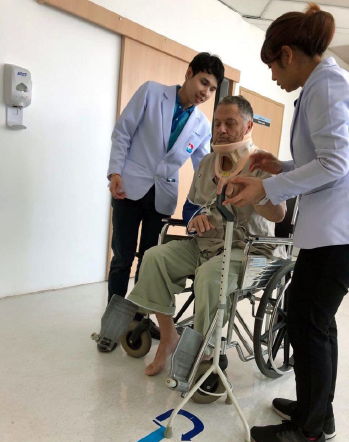I have been an emergency physician for over three decades. I am partially blind but have remained active doing medical mission work overseas. In December 2018, I went on a medical mission trip with another emergency physician to Thailand. Afterward, I extended my travel to explore more of Asia and make my way to Cambodia. I had heard of a charitable hospital called Sonja Kill Memorial Hospital in Kampot, Cambodia, so I wanted to visit them to see if I could be of service. However, my plans were suddenly interrupted when passing through Laos on my way there.
Explore This Issue
ACEP Now: Vol 40 – No 02 – February 2021My Accident
I was walking along a highway in Laos. It was dark. A semi-trailer swerved off the road and struck me. I suffered a brief loss of consciousness. I woke up in a rice paddy on my back, quadriplegic, and starving for air. Immediately, I concluded that I had severed my spinal cord at a high level. I was ready to die as I stared at the beautiful moon and stars. What actually had happened was that I fractured my C4 and C5 and my spinal cord was in “shock.” I passed out from asphyxia.

Dr. Wernecke about a month into his recovery, learning to walk and balance after an extremity fracture and overall debility.
When I regained consciousness, I knew I was in critical condition. I was in severe pain and desperately struggling to breathe. I took a few moments to do a secondary survey on myself. I had an open fracture of my left lower extremity, broken neck (which turned out to be teardrop fractures at C4 and C5), several rib fractures, a hemopneumothorax, an exploded right shoulder, and paralyzed right upper extremity. I could taste blood, but other than facial abrasions and swelling, my cranium seemed intact. I had abdomen pain, but on exam, I was soft and not peritoneal. I was still cognitively intact. I realized if I were to have a chance of survival, I would need help. But nobody was there.
It took what seemed like forever to crawl back to the highway. The passersby would not stop. After about 20 minutes lying next to the highway, in plain sight, I had no option but to use myself to try to stop traffic. I crawled into oncoming traffic, hoping the drivers would see me and stop. It worked. I was scooped up and thrown in a pickup bed. I bounced my way to the nearest hospital.
The facility was not well-equipped but managed to give me the large needle I requested. I knew I at least had a pneumothorax, as subcutaneous air was accumulating around my chest and neck. I wanted to be prepared to perform an auto-thoracostomy if tension built up.
The hospital workers put me in the back of an old van, and I bounced around for four hours to the next hospital. Four hours of hell. I thought of late Sen. John McCain’s experience in a rice paddy.
Pages: 1 2 3 | Single Page





One Response to “Make Sure You Prepare for Possible Medical Emergencies When Abroad”
February 20, 2021
JillMany of us prayed for you not knowing you, but your friend Cheryl who has been on many missions with you, asked us to pray. She was very distressed when she learned of your accident. Part of her heart will always be in Chiang Mai. She shared this article with us. Praise God and thank you for your mission work.